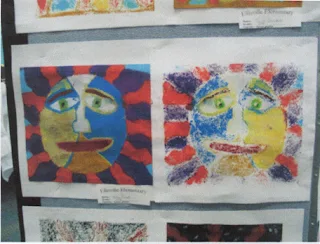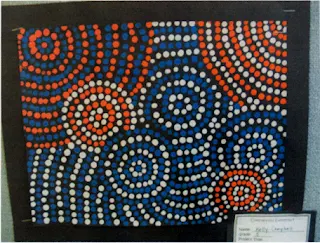Title: African Masks From Recycled Materials: Flat Cardboard Construction
Topic: recycling, African culture
Goals and Objectives:
- Students will make three-dimensional masks representing elements and principles of design used by African indigenous cultures.
- Students will use recycled materials to construct an original mask.
- Students will conduct research in the library or computer lab.
GLEs:
STRAND I: Product/Performance
3. Communicate ideas about subject matter and themes in artworks created for various purposes
A. High School Level I
- Create original artworks using non-objective, architecture and anatomy subject matters.
STRAND IV: Interdisciplinary Connections (IC)
1. Explain connections between visual art and performing arts
A. High School Level I
- Connect meanings of elements in art with terms in music, theatre, or dance
STRAND III: Artistic Perceptions (AP)
2. Analyze and evaluate art using art vocabulary
A. Art Criticism: High School Level I: With one artwork:
- describe artwork;
- analyze the use of elements and principles in the work;
- Interpret the meaning of the work (subject, theme, symbolism, message communicated);
- Judge the work from various perspectives:
- Showing a real or idealized image of life (Imitationalism)
- Expressing feelings (Emotionalism/ Expressionism)
- Emphasis on elements and principles (Formalism)
- Serving a purpose in the society or culture (Functionalism)
STRAND II: Elements and Principles (EP)
2. Select and use principles of art for their effect in communicating ideas through artwork
E. Unity: High School Level I
· Explain how elements and principles create unity in artworks
STRAND II: Elements and Principles (EP)
2. Select and use principles of art for their effect in communicating ideas through artwork
F. Proportion: High School Level I
· Identify and use realistic facial proportions
STRAND II: Elements and Principles (EP)
2. Select and use principles of art for their effect in communicating ideas through artwork
B. Emphasis: High School Level I
· Identify and create emphasis (focal point) through contrast and convergence
Grade: 9th – 12th
Length of Class Period: 55 minutes
Frequency of Class Period: five days a week
Time Needed: six class periods
Facility & Equipment Requirements:
- One computer lap top
- Room with good lighting
- Large tables, approximately ten, each seating four students
- Two sinks
- Dry erase board
- Drying racks
- Cabinets for storage
- Projector for viewing computer video, CDs and DVDs
Resources Needed:
- Research Questions and Identification of Tribes
- Card Game About Tribal Identification
- Power Point About African Designs
Materials Per Student:
- Several large cardboard boxes
- Scissors
- Masking tape
- Newsprint
- Wheat paste
- White glue
- Acrylic paints
- Paint brushes
- Varnish or Modge-Podge (optional)
- A variety of decorative recyclables like: beans, pods, plastic parts, wood chips, twine, feathers, construction paper, magazines etc...
Vocabulary/Terminology:
- Indigenous - are ethnic groups that are defined as indigenous according to one of the various definitions of the term, there is no universally accepted definition but most of which carry connotations of being the "original inhabitants" of a territory.
- Tribe - A tribe, viewed historically or developmentally, consists of a social group existing before the development of, or outside of, states.
- Mask - a protective covering worn over the face
- Culture - the tastes in art and manners that are favored by a social group
Motivation- Looking and Talking Activity: The students play with a set of art cards. They must practice looking at tribal design elements and sort the cards according to common attributes used by each particular group. I have included the identification chart below.
Step-by-Step Studio Activity Specifics:
- Students will play a quick, challenging card game that will introduce them to this lesson plan.
- Students will watch and discuss a Power Point about African tribal designs.
- Students will spend one class period doing research in the library about a particular tribe whose masks they wish to take design elements from.
- Students will draw two versions of a mask they wish to construct.
- Students need to decide if they will make a mask from flat recycled cardboard boxes or from crushed newsprint formed over an old milk jug.
- The teacher will demonstrate the cardboard construction techniques using glue and cut, geometric pieces of cardboard.
- Students will complete their project to this point and then the instructor will demonstrate the method of layering newsprint and wheat paste on top of the cardboard mask to improve its stability.
- The masks will need to dry over night.
- Then students will be provided a variety of recycled objects and asked to glue a selection to their masks in order to create texture: beans, pods, plastic parts, wood chips, twine, feathers, construction paper, magazines etc...
- Students will paste these objects creatively according to their design ideas.
- Students will then paint the mask and apply varnish or Mod Podge.
Health & Safety Concerns: There are no health and safety concerns for this project.
Cleanup Time & Strategy: Students will be instructed to put away art materials neatly in their containers, clean off their tables, and recycle their trash two minutes prior to dismissal.
Assessment: A formal assessment/grading rubric sheet is included along with this lesson plan in the student teacher binder.
all articles and lesson plans are copyrighted 2011 by Grimm
























